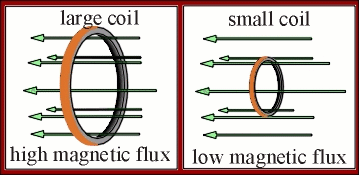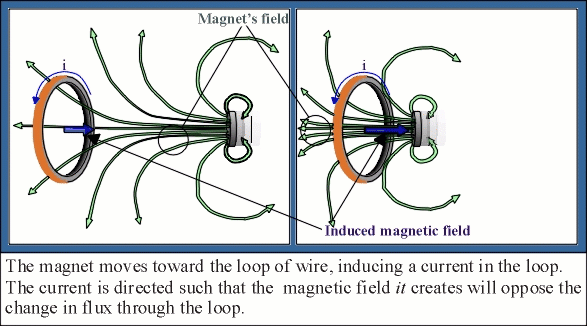This simple demonstration shows a strong magnet can cause current to flow in a coil of wire.
WATCH VIDEOS
Teachable Topics:
- Magnetic fields
- Flux
- Faraday's Law
- Electromotive Force
Theory:
A conducting loop in a magnetic field may have magnetic flux through it. Magnetic flux, ΦB, is defined by the following integral:

Flux can be thought of as the amount of magnetic field (represented in the diagrams below by green arrows) directed through the loop. Flux can be varied in the following three ways:
1. By changing the orientation of the loop in the field.
If the field passes through the flat side of the loop, the flux is greater than if the field lines lie parallel to the side of the loop

2. By changing the area of the loop.
More area allows more magnetic field to be directed through the loo

3. By varying the magnetic field strength.
This can be done in many ways; one way is to draw a bar magnet closer or further away from the loop

Changing the flux through a loop of wire induces an EMF in the loop, and this EMF causes current to flow. Faraday's law relates the induced EMF, e, to the rate of change of the flux, dΦB/dt.
The fact that e is proportional to dFB/dt means that the quicker FB is changed, the stronger the EMF (and thus the current) is induced. The negative sign indicates the direction of an induced current. The induced current flows in a direction to oppose changes to the magnetic field through the loop. An example may help to clarify what this means. Consider a magnet moving toward a loop from the right, north pole first. To oppose the increasing flux through the loop, current flows counter-clockwise to create a magnetic field directed to the right.

If the magnet (now close to the loop) is drawn away, then the magnetic flux through the loop decreases. To counter this change, current flows clockwise in the loop to create a magnetic field directed to the left.

Apparatus:
- magnet
- ammeter
- coil of wire (a solenoid)
- two wires
Procedure:
- Attach one wire between the ammeter and one end of the solenoid.
- Connect the other end of the solenoid and the ammeter with the second wire.
- Quickly thrust the magnet up to the opening of the solenoid. The ammeter should show a current in the coil.
- Quickly pulling the magnet away from the opening should induce a current in the opposite direction.
- Again, push the magnet toward the solenoid and pull it away again, but this time move the magnet more slowly. The ammeter should show that current is again induced in the solenoid, but because the magnet is moving more slowly, the flux through the solenoid is changing more slowly. Consequently, the induced current is not as strong as before



